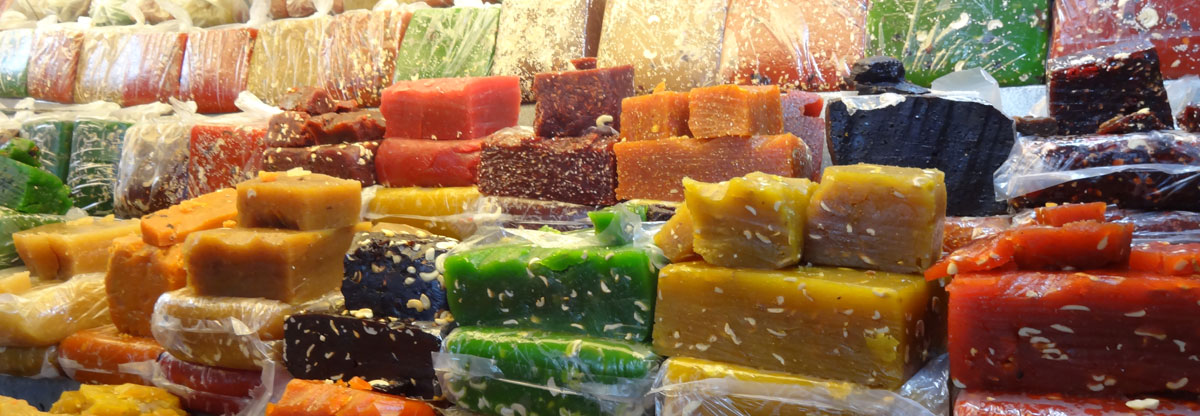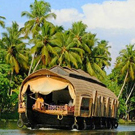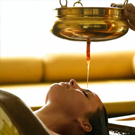A major tourist destination in the north of Kerala, Kozhikoke offers visitors, both, history and leisure. Famous for its traditional boat-building yard, timber industry, historic temples and churches, Kozhikode also offers a sumptuous variety of South Indian, North Indian, European, Chinese, Arab, Gujarati and Jain food. Kozhikode cuisine bears markedly European and Arabic influences and is famous for its sweet ‘Halwa’.
Once the capital of the proud but hospitable Samoothiri (Zamorin) dynasty who have ruled here since the Middle Ages, Kozhikode was also the headquarters of the erstwhile Malabar District under British occupation.
British colonizers of the city named calico fabric after ‘Calicut’ (the name given to Kozhikode by the British). Kozhikode was once renowned as a market for trade in oriental spices, one much visited by world travelers since classical antiquity. The Arabs who have been trading here since the 7th century AD have left their cultural and culinary imprint here; as did the Portuguese, the French, the Dutch and the English who all gained a foothold (in the form of factories and trading rights). Undoubtedly a city with a culture uniquely its own.
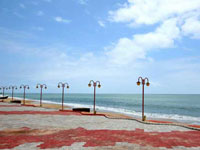
KOZHIKODE BEACH
Two ancient crumbling piers jutting out into the sea, where spices where loaded on to ships bound for foreign ports from the crumbling north pier built in 1871, in a sense, mark the antiquity of Kozhikode beach. Pitched naval battles were once fought off this shore centuries ago. Nearby the French once had a factory and settlement. Beside the south pier is ‘Horse Jumping Point’, where horses imported from Gujarat and Arabia were made to leap into the water from the boats that brought them, swim ashore and gallop along the beach before being displayed for sale.
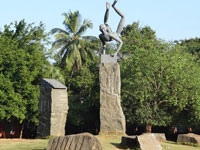
S.M. STREET AND MANACHIRA SQUARE
Reputedly Kozhikode’s busiest street today, S.M. Street stands for ‘Sweet Meat Street’. The shops along the street sell a lot else besides sweets, nevertheless along with crisp fried chips the sweetshops remain the main attraction.
Six hundred years old and once occupied by the famed confectioners from Gujurat, S.M. Street today buzzes with commercial activity. An abandoned Parsi cemetery located in the area finds mention William Logan’s Malabar Manual and is authoritatively dated from the 17th century.
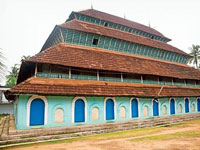
MISHKAL MASJID
One of the oldest mosques in the Malabar region, the Mishkal Masjid is one of Kerala’s most important cultural, historical and architectural monuments. Located in Kozhikode’s Kuttichira area, the mosque is named after its builder, a rich Arab trader from the 14th century called Nakhooda Mishkal.
Typical of old Malabar mosques, the structure is built primarily with timber and has no cupolas and minarets. Many historians are of the opinion that the structure’s design was influenced by local Hindu temple architecture. Once composed of five stories, the mosque was partially burnt in a Portuguese attack on the city in 1510.
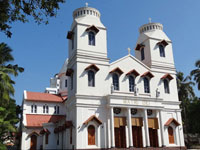
MOTHER OF GOD CATHEDRAL
In 1513 AD the Portuguese, on the invitation of the Zamorin ruler, established a factory and a church dedicated to Matre de Deo (Mother of God) at Kozhikode near the beach. In 1742 architects from Italy were brought down especially to build this church – a marvelous Gothic structure with curved arches and colonnaded spires in the neo-Roman style, an enduring testimony to aesthetic sensibilities of its designers and the undeniable skills of the Indian artisans who helped lend concrete form to the structure. A 200-year-old portrait of St. Mary adorns a wall within the church.
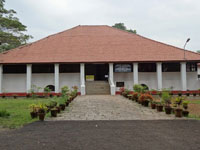
PAZHASSI RAJA MUSUEM
Named after Pazahassiraja Kerala Varma of the Kottayam royal family who led the ‘Pazhassi Revolt’ against the British East India Company during the second half of the 16th century, the museum contains ancient artifacts from the Megalithic age and the Indus Valley Civilization – pottery, toys, stone and metal figurines besides coins, models of temples, burial urns and umbrella stones, a collection of war weapons and caps once used by British and French soldiers, Panchaloha idols and stone statues from different points in history.
Adjacent to the museum, run the State Archeology Department, is an art gallery housing some of the finest works of one of India’s greatest painters, Raja Ravi Varma.
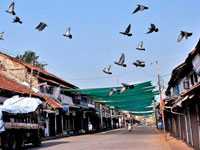
VALIYANGAADI
Valiyangadi is one of the oldest and primary commercial centres in Kozhikode lining a narrow street with a 600 year history. Here Muslims, Jains, Hindu Seths, Guajarati and Marwari moneylenders, Tamil and Andhra Chettis live check by jowl and pursue their trades just as their ancestors did many hundred years ago. Many of the merchants and accountants here still use a unique system of finger-code language first recorded in his journal by Ma Huang in 1403.
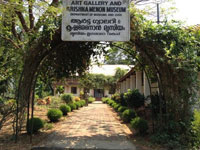
KRISHNA MENON MUSEUM
A few kilometers from the heart of Kozhikode stands the Krishna Menon Museum on East Hill. Apart from a section devoted to the memorabilia of the former Indian Defence Minister and national leader, the late V.K. Krishna Menon, the museum also houses a good collection of paintings by Raja Ravi Varma and Raja RajaVarma.
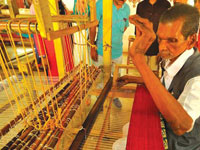
IRINGAL CRAFTS VILLAGE
Spread over 20acres beside the Chaliyar river, the crafts village has about 220 artisans working here. Working mostly with metal and natural material like banana fiber, coir, bamboo, sand, coconut shells and husk, palm leaves, and screw-pine, the raw material is then are transformed into a variety of everyday products: table mats, ladles and spoons, furniture, purses, exquisite jewel boxes and vividly colored performance masques.
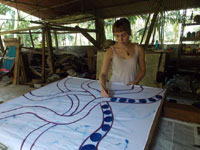
TASARA CREATIVE CENTER
Showcasing weaving, dyeing and print making, TASARA is essentially an initiative with the specific purpose of bring together artists and weavers and providing them with an environment that enables them to create a new aesthetic sensibility, transcending the limitations of their respective media. Situated in serene surroundings in the village of Beypore, outside Kozhikode, visitors to the centre may opt to observe and participate in the learning about the intricacies of yarn, weave and loom.
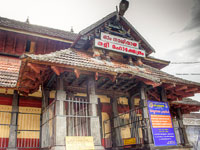
TALI TEMPLE
Believed to have been built in the 12th century AD, the temple was one of two royal temples patronized by the Zamorin rulers of Calicut, it remains an important religious and spiritual landmarks in Kozhikode. It was once the site for a social agitation in 1911, today, an annual competition between groups of religious scholar and philosophers is held here. The Tali temple remains, to this day, one of the most important spiritual and cultural centers in Kozhikode.
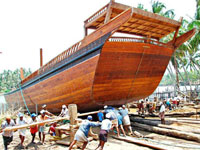
BEYPORE PORT AND FISHING HARBOR
The hardy dhows built in the boatyards of Beypore evoked much admiration from European seafarers and Arab traders. Called ‘dhows’ in Arabic or ‘urus’ in Malayalam, they are reputed to have played a part in the Battle of Trafalgar.
The boatyards, situated in the village of Beypore, at the mouth of the Chaliyar River, even now follow an ancient system to design the boats, later, building them entirely of wood, mostly for wealthy clients in Arab countries.
A visit to the port and boatyards in Beypore is in many aspects a journey into the past – dhows still sail serenely out into the ocean at dawn, gulls hover overhead just birds before them did for hundreds of years, and the rhythm of wood being fashioned into doughty vessels.
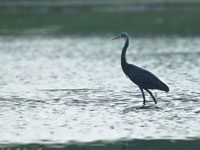
KADALUNDI BIRD SANCTUARY
Visitors will be dazzled by over a hundred species of birds both migratory and endemic in the Kadalundi Bird Sanctuary, a cluster of islands surrounded by hillocks with the Kadalundipuzha River flowing into the Arabian Sea nearby. Terns, gulls, herons, sandpipers, cormorants, whimbrels and brahminy kites, turnstones, red and greenshanks and many more flock to these shores in large numbers from November to April. Kadalundi is also known for a wide variety of fish, mussels and crabs. The mangrove vegetation here shelters otters and jackals.
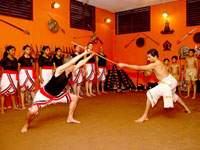
CVN KALARI SANGAM
‘Kalarippayat’, an ancient martial art-form that evolved over centuries in Kerala. Today, as well known as the dance form of ‘Kathakali’, Kalarippayat is not only a martial art but also a physical discipline aimed at a perfectly fluid blending of bodily and mental powers, a discipline that includes meditation techniques and regular Ayurvedic massages to condition the body and mind.
On a visit to the CVN Kalari, a pre-eminent institution, guest will watch trainees of all ages, children and adults go through the rigorous stamina-building exercises that turns out the perfect Kalari warrior.
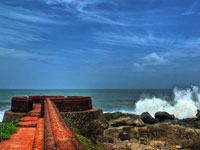
BEKAL
Aserene coastal Kerala landscape with an expanse of beach, hills, river and backwaters (with water sport facilities!) forming the setting for the focal point of the entire frame – the fort of Bekal!
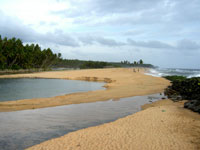
BEKAL FORT AND BEACH
Shaped like a gigantic keyhole, the Bekal fort, in North Kerala, is the largest and best preserved fort in Kerala. Built on a rise strewn with rock, the sea comes up at high tide to lash against the base of the forts ramparts. A formidable fortification brilliantly using the topography to advantage, the fort is believed to have been built sometime in the early 13th century. Its purpose appears to be military as the forty acres inside the fort do not contain a palace or administrative buildings save for a temple and mosque.
Apart from the large tank with a flight of steps, features of the fort worthy of note are the zigzagging paths to the entrance of the fort, trenches around the fort, a magazine, a tunnel, ports for guns at various levels on the outer walls, designed in order to enable defenders cover the entire field of fire. A tall Observation Tower offers a panoramic view of the surrounding landscape, the blue expanse of the Arabian Sea and gorgeous sunsets that are not to be missed.
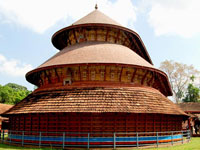
MADHUR TEMPLE
Located 7 km from Kasaragod town is the Madhur temple, one of six Ganapathi temples of ancient Tulunadu. Lore has it that an old low caste lady, Madaru, discovered an ‘Udbhava Murthy’ (a statue not made by human hands) of a Sivalingahere. The statue of Lord Ganapathiis said to have been drawn by the priest’s small Brahmin son on the walls of the sanctum sanctorum while he was playing. The statue miraculously grew bigger and fatter day by day so that it came to be called ‘boddajja’ or ‘boddaganesha’. Further legend holds that Tipu Sultan,who had initially wanted to destroy the temple like he had others during his invasion of the region, changed his mind after drinking water from the temple well. In order to appease his soldiers and Islamic scholars, he, however, deigned to make a symbolic gash with his sword to signify the attack. That mark is still visible!
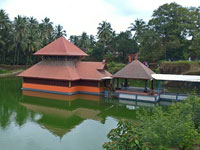
ANANTHAPURA LAKE TEMPLE
The only lake temple in Kerala, it stands on a hillock looking down at the Ananthapura Lake. The temple has an interesting history, according to a legend, this is the spot where Lord Ananthapadmanabha chose to settle down before he made his way through a cave beside the lake to hiseventual place of rest in Thiruvananthapuram hundreds of miles away. The cave opens out to a small pond where the water level remains steady regardless of climatic changes.
Visitors will be interested in thethe interiors of the temple with its mural painted walls and the traditional ‘chuttambalam’ around the sanctum that accessed through a bridge.
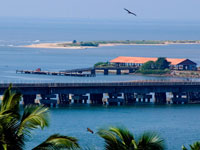
CHANDRAGIRI FORT AND RIVER
This ruined 17th century fort with its eventful history stands on the banks of the Changragiri river and once served as the boundary of two powerful kingdoms of the time. With the fall of the Vijayanagar empire in the 16th century, the vassal of the area, Vengappa Nayaka, declared his independence. When his successor and son Shivappa Nayaka, took over the reins, he built numerous forts, one of which is the Chandragiri fort.


